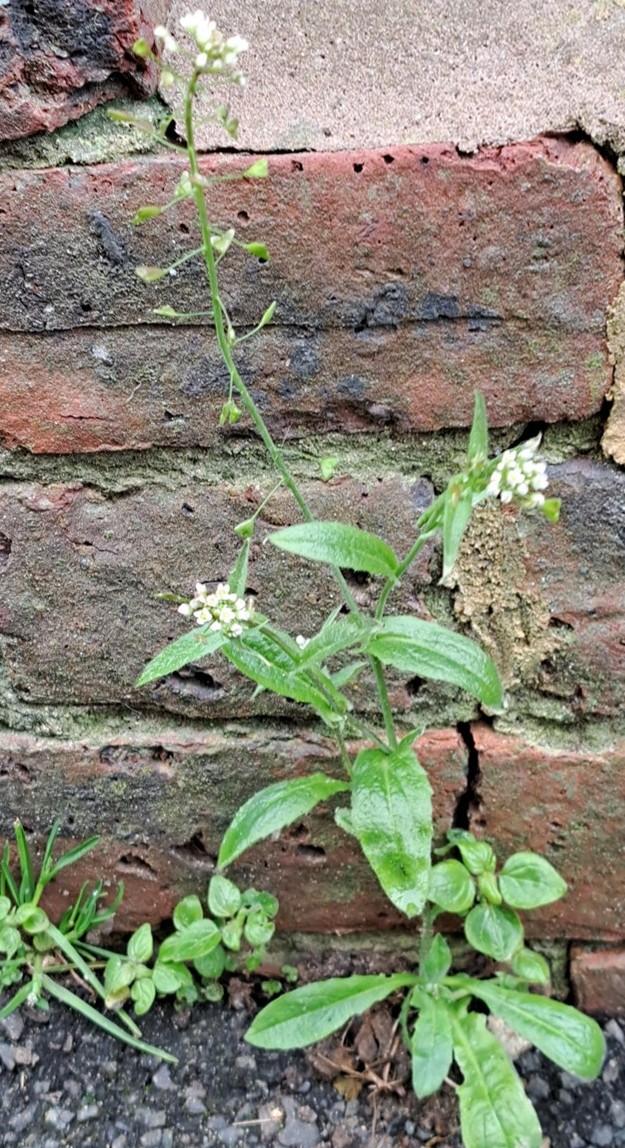Ever stopped to notice those little white flowers in the pavement edges? Brian helps with identification of these small but fascinating plants!
A – This is the Danish Scurvygrass – Cochlearia danica that we hiked down from the Crouch to see. The ivy-shaped leaves are a give-away. “Cochleare” is botanical Latin for spoon which refers to the spoonshape of the English Scurvygrass leaves C. officianalis (and it was used to prevent scurvy).
B – Easy one, Shepherd’s Purse. Heart shaped seed pods are the give away but note the leaves as well, which clasp the stem.

Capsella bursa-pastoris
Shepherd’s Cress (Teesdalia) has similar seed pods but very different “jizz”. We would be interested to know if you spot this in Seaford!
C – Cardaminē (Pronounce the e as in Aphrodite!)
Note the long seed pods here and especially the shape of the leaves. This is Cardamine (Classical Greek for “cresses”). This particular one is Cardamine flexuosa. Wavy Bitter-cress


Cardamine flexuosa Flower, characteristic stem leaves and double bend in the stem

It is a perennial. Note the large leaf (A) is Shepherd’s Purse and the smaller ones (B) are Chickweed.
A very similar relative is Hairy Bitter-cress – Cardamine hirsuta. That is an annual and the stems are straight. A more technical difference is that it only has 4 stamens while flexuosa has 6 (though 2 are very small) Sightings welcome of this one in Seaford!
D – Sweet-Alison (Lobularia maritima). Introduced as a garden plant from the Mediterranean, where it naturally grows in dry rocky places (as well as being grown in gardens). It is well naturalized here in walls and pavement cracks.
Here it is growing on a wall with Erigeron karvinskianus (Mexican fleabane).
Campion family
E – Common Chickweed
Stellaria media. What looks like 9 or 10 petals is really 5 that are each deeply divided into two. It is a common member of the pavement comunity
F – Sticky Mouse-ear
This photo shows the plant in grass but it grows around pavements too e.g. at the base of the telephone box on the crouch. (lower photo). The soft hairy leaves are the “mouse ears”.
Cerastium glomeratum. “Glomeratum” referring to the clustered flower heads. When they open the flowers have 5 petals
G – Common mouse-ear
Cerastium fontanum (not seen yet) has very similar leaves but more open flower heads. Should be out soon and it is very common.
Cerastium means horned (e.g. rhinoceros) which refers to the shape of the fruiting capsule of members of this genus.
Pedant’s corner
The Shepherd’s purse, the Scurvy-Grass, the Cardamine and the Alison are all Crucifers (Cabbage family Brassicaceae) with 4 petalled flowers forming a cross. A better known Cardamine (Cardamine pratensis) is Cuckoo Flower or Lady’s smock, … pratensis “of the field” (out soon)
The Chickweed and the Mouse-Ear are Caryophylls (Campion family Caryophyllaceae) in which 5 petals, are usual but they are often bifid as in Chickweed.
Normally a Latin Family name should be derived from one of the genera in the family (Asteraceae, Brassicaceae) but I do not think there is any genus Caryophyllus now..
This name Caryophyllus is actually Greek which means nut-leafed. It was applied to the Clove tree which was named Caryophyllus aromaticus by Linnaeus but it was reclassified and named Syzygium aromaticum in the 20C. It is not a Caryophyll but in the Myrtle family.
Instead, the name “Caryophyllus” has been used by post-Linnean classifiers to apply to various species which have the fancied smell or colour of cloves. Not many of these are Caryophylls either but one example that actually is in the family is Dianthus caryophyllus which is the wild “Carnation” of the Mediterranean and which still retains its original Linnean name!
Check out Dianthus caryophyllus – Wikipedia
Words and photos Brian Livingstone









